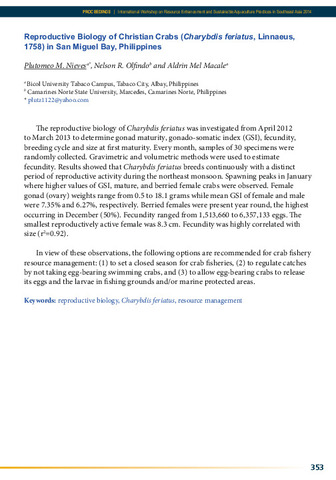Reproductive biology of christian crabs (Charybdis feriatus, Linnaeus, 1758) in San Miguel Bay, Philippines
Share
Abstract
The reproductive biology of Charybdis feriatus was investigated from April 2012 to March 2013 to determine gonad maturity, gonado-somatic index (GSI), fecundity, breeding cycle and size at first maturity. Every month, samples of 30 specimens were randomly collected. Gravimetric and volumetric methods were used to estimate fecundity. Results showed that Charybdis feriatus breeds continuously with a distinct period of reproductive activity during the northeast monsoon. Spawning peaks in January where higher values of GSI, mature, and berried female crabs were observed. Female gonad (ovary) weights range from 0.5 to 18.1 grams while mean GSI of female and male were 7.35% and 6.27%, respectively. Berried females were present year round, the highest occurring in December (50%). Fecundity ranged from 1,513,660 to 6,357,133 eggs. The smallest reproductively active female was 8.3 cm. Fecundity was highly correlated with size (r2=0.92).
In view of these observations, the following options are recommended for crab fishery resource management: (1) to set a closed season for crab fisheries, (2) to regulate catches by not taking egg-bearing swimming crabs, and (3) to allow egg-bearing crabs to release its eggs and the larvae in fishing grounds and/or marine protected areas.
Description
Abstract only.
Suggested Citation
Nieves, P. M., Olfindo, N. R., & Macale, A. M. (2015). Reproductive biology of christian crabs (Charybdis feriatus, Linnaeus, 1758) in San Miguel Bay, Philippines. In M. R. R. Romana-Eguia, F. D. Parado-Estepa, N. D. Salayo, & M. J. H. Lebata-Ramos (Eds.), Resource Enhancement and Sustainable Aquaculture Practices in Southeast Asia: Challenges in Responsible Production of Aquatic Species: Proceedings of the International Workshop on Resource Enhancement and Sustainable Aquaculture Practices in Southeast Asia 2014 (RESA) (p. 353). Tigbauan, Iloilo, Philippines: Aquaculture Department, Southeast Asian Fisheries Development Center.

